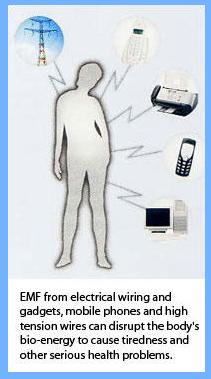|
|
EMF: Electromagnetic field
|
|
Scientists agree that EMFs pose a threat to your health.
Electricity has become an integral part of our lives, with electromagnetic fields (EMFs) all around us. Electricity certainly makes our lives easier in many ways. Is it possible that electricity is also making our lives shorter?
Most experts agree that some limited exposure to EMFs is not a threat. We can feel reasonably safe using a toaster, for example. The problem comes when we are chronically exposed to large does of EMFs such as encountered when living near power lines or sleeping in the room where the power enters the house. Unfortunately, this type of chronic exposure to EMFs applies to millions of Americans.
Negative effects of EMF exposure
The effect of EMFs on biological tissue remains controversial. Virtually all scientists agree that more research is necessary to determine safe or dangerous levels. What they do know is that iron, which is necessary for healthy blood and is stored in the brain, is highly affected by EMFs. The permeability of the cell membranes of nerves, blood vessels, skin and other organs is also affected, as well as the intricate DNA of the chromosomes. Every bodily biochemical process involves precisely choreographed movement of EMF sensitive atoms, molecules, and ions.
 Dr. David Carpenter, Dean of the School of Public Health, SUNY, has reported that up to 30 percent of all childhood cancers may be due to exposure to residential powerlines.
Epidemiological studies in Sweden by Maria Feychting showed that persons exposed to high magnetic field at home and at work had 3.7 times the risk of developing leukemia compared to those not exposed.
Two research reports have identified elevated risks of breast cancer among women working jobs with presumed higher than average exposure to EMFs.
If you want to follow the Environmental Protection Agency's advice to prudently avoid EMFs, you may want to invest in a Gauss meter to measure your home, work or school environments, both inside and outside.
Link to: Invisible Dangers of Cell Phone Radiation.
What is a Gauss Meter?
A Gauss is a common unit of measurement of magnectic field strength. The Gauss meter is a tool for measuring Gauss values. Inside a Gauss meter is a coil of thin wire. As a magnetic field radiates through the coil, it induces a current, which is amplified by the circuitry inside the Gauss meter.
These meters vary in the strength of magnetic fields they are able to measure. A meter used for measuring EMFs from power lines, transformers, substations and appliances should be able to measure as low as .1 mg.
Gauss meters vary in price and accuracy. They have either a single axis coil or a triple axis coil, with the single axis being much simpler and therefore much less expensive. To use the single axis meter, you point its one sensor in three directions, the X, Y and Z axes, and combine the readings in an equation to calculate the combined field strength. The triple axis meters are more complicated in their operations, but produce more accurate results.
Another consideration is whether the meter is frequency weighted. Most meters read the same EMF strength no matter what the frequency. Since the human body appears to be sensitive to both the field strength and the frequency, meters should be frequency weighted. The frequency weighting feature is why these meters will show a higher EMF reading than those typically used by electricians and engineers.
Power lines, substations and transformers
Power generating stations produce enormous amounts of electricity and send it through high voltage wires. All power lines radiate electromagnetic fields, with the exact amount depending on its particular configuration. Power companies know which configurations are best for limiting EMFs but most don't feel the evidence against EMFs supports their making costly changes in the way they deliver electricity.
A substation is where the conversion from transmission to distribution takes place. Through an assemblage of circuit breakers, switches and transformers, the electrical current is stepped down to the power grid. A good bit of public concern about the threat of EMFs has revolved around the substation, which has been seen as the cause of cancer clusters among nearby residents.
A component of a utility's electrical distribution network depends on numerous transformers mounted on power poles. These transformers look like small cylindrical trash cans. When the electrical service is buried underground, you will see a metal box located on the ground near the street. Although many people don't know a transformer when they see it, the power line feeding the transformer is carrying 4000 to 13,000 volts. The transformer then reduces the voltage to the 120-/240 current needed by the nearby homes.
EMFs near a transformer can be very high, but the field strength diminishes rapidly with distance. For this reason, having a transformer located near your home should not be a major concern, but you might want to measure the field strength around the transformer to be sure.
|